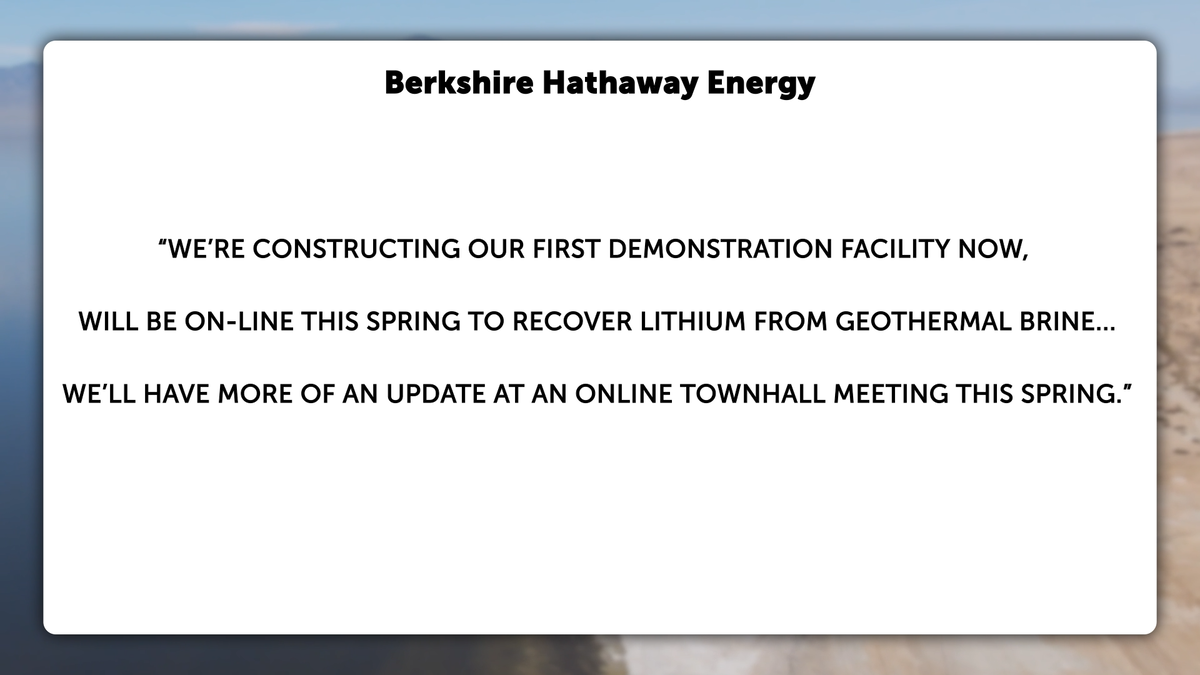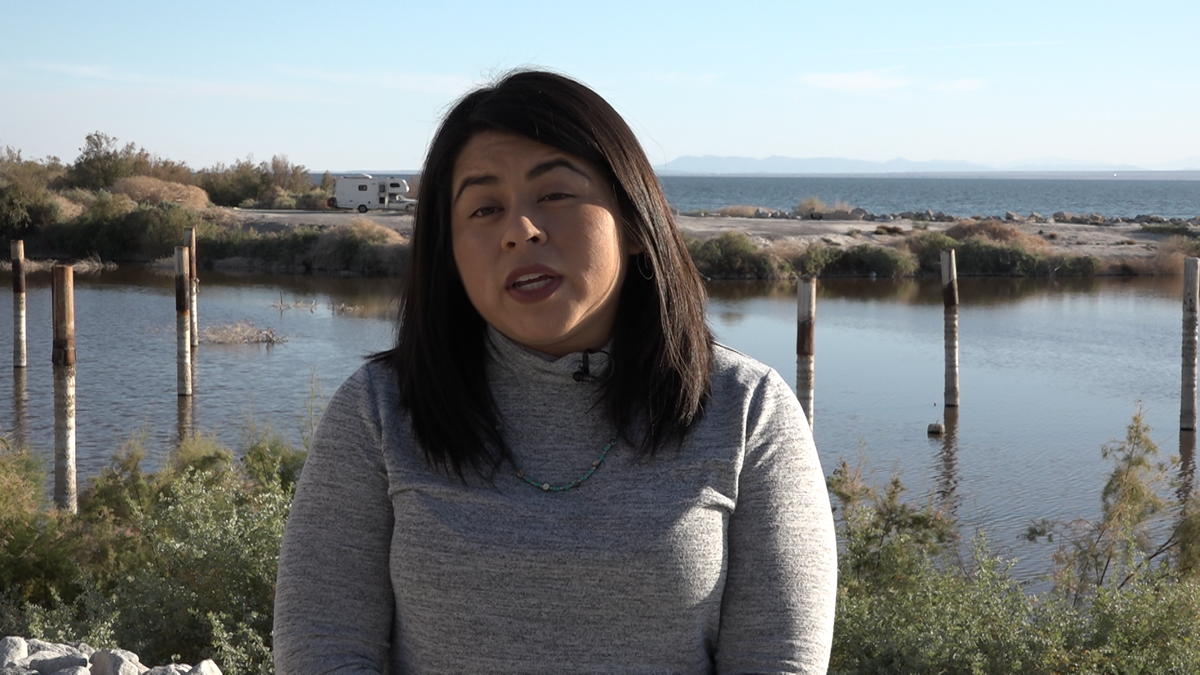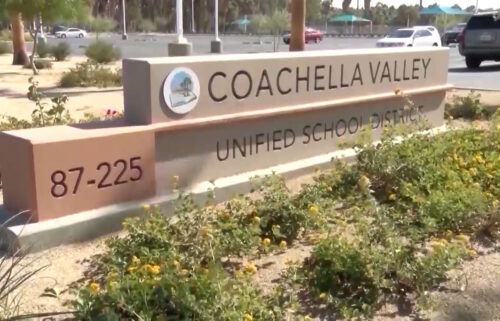‘A clean energy economy’ for everyone? Salton Sea residents are not convinced yet
Residents in Salton Sea communities are demanding answers on the potential impacts of lithium extraction projects in the region.
They’re calling on local, state, and industry leaders to offer details about how their health and the environment may not benefit from a market which supporters tout as a sustainable energy solution.
Patricia Leal Gutierrez, a resident of North Shore, said she has seen first hand how the Salton Sea has deteriorated. She explained as it "shrinks it exposes dust, and that dust is particulate matter so fine that it comes into the lungs.”
Although Gutierrez lives on the north end of the lake, miles away from what’s known as the Geothermal Resource Area in Imperial County where a trial run is taking place to determine if commercial lithium can be extracted, she still has concerns.
Gutierrez said “it’s not only going to impact residents in the southern end, it’s really going to impact the entire region,” in reference to the ongoing pilot programs.
Governor Gavin Newsom recently touted in a press release that California already has nearly 500,000 green energy jobs, which is two times more than any other state. Geothermal lithium represents an opportunity to expand those figures.
Newsom joined President Joe Biden on February 22 for a virtual event on the energy industry. The president announced a $35 million award to "MP Materials, to separate and process heavy rare earth elements at its facility in Mountain Pass, California, establishing a full end-to-end domestic permanent magnet supply chain."
President Biden highlighted the potential for economic development as another benefit of California's lithium reserve. He outlined his vision, which includes the creation of jobs he believes will "set America up to lead the world in building a clean energy economy.”

Berkshire Hathaway Energy Renewables (BHE Renewables) also announced Tuesday plans to break ground on a new demonstration facility in Imperial County, California, this spring to test the commercial viability of their lithium extraction process from geothermal brine as part of a multibillion-dollar investment.

If successful, the company a path towards commercial scale production of battery grade lithium hydroxide and lithium carbonate by 2026. Imperial Valley contains some of the largest deposits of lithium in the world. Once at scale, BHE Renewables facilities could produce 90,000 metric tons of lithium per year.
The company owns and operates nearly a dozen geothermal plants at the Salton Sea in Imperial County. Researchers say the Salton Sea has could supply one third of the world’s lithium, which is used for lithium-ion batteries in electric cars, cell phones, laptop computers, power tools, and other devices.

However, residents in communities surrounding the lake have said they want to know exactly how their lives may change, if plans continue to progress in the region thats now been dubbed "Lithium Valley."
Patricia Leal Gutierrez said that she and others in the community "need to be able to understand the research and the impacts in a way where it's not being rushed." She added that there is concern from community members because they don't have the information they want "to feel confident about this work.”
Gutierrez said she would also like to know how many and what types of jobs would be created as part of the Salton Sea extraction projects.

California Assemblymember Eduardo Garcia, who represents the 56th which includes cities and unincorporated communities in eastern Riverside County and Imperial County, told News Channel 3 "that right now is yet to be determined in terms of a precise number."
Meanwhile, there are residents that are prioritizing the economic development aspects of the Salton Sea lithium projects, and want current plans to go even further
Frank Salazar, an Imperial resident, said he would like to see “battery manufacturing, plant production, car production, long-term construction, long-term creation" and education and research opportunities for local residents in the region.
The Chair of California Energy Commission, David Hochschild, said the agency is exploring whether its an option "to co-locate battery manufacturing onsite and just have a pipe from the lithium production to a battery manufacturing facility right there and then you eliminate the costly process on both sides and the transportation cost."
Hochschild added, "we want to do everything we can to provide the tax credits and other grants and rebates to support that happening locally." He said "right now the vast majorities of batteries are coming to us from China" so the goal is to "have greater independence and a stronger domestic clean energy supply chain."
The head of the CEC noted that $16 million in research and development grants have already been distributed, and there "will be more to follow." Hochschild also said "many hundreds of millions of dollars in tax credits are are now being made available to support more investment in the region."
Hochschild also noted that "one of the most important pieces of work still to come is to work out exactly what the royalty structure looks like. What we want to do is end up with a process where we do have a royalty thats assessed on every ton of lithium that comes out and that that fee then foes and supports local priorities, including infrastructure, and ob training and other measures that are going to lift up" community.
The CEC created The Lithium Valley Commission to analyze the potential benefits of lithium extraction in the region.
It holds virtual monthly meetings to share information with the public, but sessions last for hours and usually take place in the middle of the day.
Mariela Loera, a policy advocate for the Leadership Counsel for Justice and Accountability, explained the organization is working to bridge the communication gap between community and state agencies and representatives. Loera noted it's not always possible since "the response that we get is we don’t know the answers, this hasn’t been done in a commercial scale so we don’t have the answers.”
There is not much publicly available data on the Lithium Valley projects. However, Loera noted that in one environmental impact report she was able to access and examine "it does say that for operations that project is going to use up 90,000 gallons of water per hour so that’s really concerning considering that IID is the one providing the water and we know that IID gets water from the Colorado River, which we know is in a drought.”
The Leadership Council for Justice and Accountability says there’s also concerns about earthquakes and air pollution as a result of extraction.
The Salton Sea region has, for years, already been plagued by high unemployment, environmental, and health crises. Patricia Leal Gutierrez stressed the importance of the surrounding community getting detailed answers to all of their questions because "the long term effects can really be a negative for the people living here.”
Troubled Waters: The Salton Sea Project is a special four-part series in which News Channel 3 morning anchor Angela Chen takes a look at the history, ongoing issues, and the fight for the future of the Salton Sea.
Click here to visit our Salton Sea Project section to learn more about the special report
- Part 1: Paradise Lost - Angela looks back at the history of the Salton Sea. Find out it's connection to Spanish explorers, and how it went from one of the most popular destination to abandoned and on the verge of disaster
- Part 2: Toxic Exposure - Angela goes in-depth on the history of toxic outbreaks at the Salton Sea and its connection to the current health issues of those who live near the lak
- Part 3: A Lake Languished - Angela looks at the millions spent over the years to save the Salton Sea and why there is so little progress to show for it
- Part 4: Salton Sea Plea - There are massive environmental problems at the Salton Sea, but after decades of neglect, could the lake's unique location be part of the solution in saving it? Angela highlights the movement happening to save the lake




